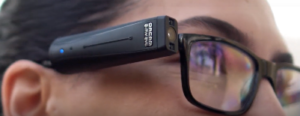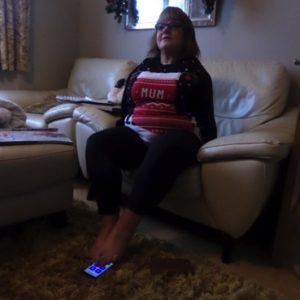OrCam – SMART Technology That Makes Things Clearer
Read beneficiary reviews of OrCam - a smart reading device to assist visually impaired people
 Technology is making a difference all over the world; not just in terms of information and communications, but in transforming the lives of people with disabilities or sensory issues.
Technology is making a difference all over the world; not just in terms of information and communications, but in transforming the lives of people with disabilities or sensory issues.
Trust volunteers Mandy De la Mare and Wendy Tomes have been researching the use of OrCam – the new assistive device that gives partially sighted and blind people the ability to ‘read’ text, books, documents and product information, and gives them facial recognition, all through a simple pair of glasses and camera, linked to an earpiece. Mandy explains: -
“When the Trust asked me to look into the benefits of OrCam I went straight to the OrCam website. Whilst it claims to give visually impaired people the ability to ‘read’ text and product information, and recognise faces, the company stresses that it doesn’t improve your eyesight. It relies on the user being able to hear, with or without a hearing aid, as information is given through the earpiece integral to the device.
I asked for more info, giving details of my disability and, after a few days I received a call from OrCam trainer, Ian White, who is himself registered blind but is actually partially sighted.
Discussion with OrCam trainer provided more details on how the device worked
I asked him whether a totally blind person, like me, could use OrCam and whether OrCam users needed to have hands to work the device as I have no hands or arms.
He explained that blind people can definitely use the device and that he knows of 24 such users in Scotland, where he operates.
However, although there may be scope for OrCam to be adapted for limb deficient users in time, you currently have to tap the device for certain commands, such as using the voice activation menus, or reading text. You also have to be able to use a pointing finger action to get the camera to focus on the text you want to read.
Scanning in photographs of people you want the camera to recognise also requires you to use your hands. A double tap on the side of the device gets the camera to take the photograph. Further tapping then helps you to attach the name of the person to the picture for the face recognition program. You need hands to position things you want to read, before holding your head steady opposite where you think the beginning of a document starts. After a short time, the camera realises what it’s supposed to be doing and starts up automatically.
Limitations with technology were identified
As well as reading texts and recognising faces, OrCam can also read the barcodes of many supermarket products, telling you what the product is along with details like weight, cost and sell-by dates. However, Ian did say that some barcodes aren’t that good, and that the camera may not recognise them, or have them in its memory. You can add barcodes to the OrCam memory for those important items you need on your shopping list.
You don’t need Internet or wireless for OrCam but you can use Bluetooth to connect it to your iPhone and download the app. This isn’t currently available for android phones, but it will be.
With Ian’s advice, I requested a demonstration. Southampton based company, Sight and Sound sent someone to my home to show me the product. He was visiting a fellow beneficiary, Wendy Tomes, who is partially sighted, on the same day, and our experiences are both given here for comparison.
 Mandy’s demonstration
Mandy’s demonstration
My demonstration took place in the early afternoon on a very wet and dark day. The demonstrator started off by showing me the glasses, which contained clear lenses. They felt very light. Then he let me feel the camera which clips onto the arm of the glasses, along with the earpiece. It made the glasses heavier to hold on one side but I managed, after a bit of difficulty, to put them on myself with my foot.
Speech facility is available for those unable to use hand gestures to operate OrCam
 The demonstrator could see straight away that using hand gestures would be no good for me so he set up the OrCam app on his demonstration iPhone with speech-over switched on, so that I could get spoken feedback of what appeared on the iPhone screen. He asked me to look at my personal assistant and get the camera to take a photograph of her by using the app on the iPhone. The camera told me straight away that she was female - which did impress me. Once I had added my PA’s name to the photograph it would say her name every time it spotted her.
The demonstrator could see straight away that using hand gestures would be no good for me so he set up the OrCam app on his demonstration iPhone with speech-over switched on, so that I could get spoken feedback of what appeared on the iPhone screen. He asked me to look at my personal assistant and get the camera to take a photograph of her by using the app on the iPhone. The camera told me straight away that she was female - which did impress me. Once I had added my PA’s name to the photograph it would say her name every time it spotted her.
When we tried to get OrCam to read text from a magazine, it struggled. It didn’t like the glossy paper and we found out that if it’s a dull day, and you have your house lights on, the OrCam camera doesn’t work that well and makes a lot of mistakes. In the end the demonstrator used an A4 sheet, telling you all about OrCam, which of course it read perfectly.
The other thing I found was that getting your head in the right position for the camera to start reading the document in the correct place was difficult when you couldn’t see it. I also prefer to work from the floor for obvious reasons, being a foot user, and the camera didn’t like looking straight down at the floor where the book was placed. Once again, it wasn’t easy to get my head in the right position to read.
Wendy’s experience
My fellow beneficiary, Wendy, had her demonstration in a well-lit opticians’ surgery where OrCam behaved well and read everything that was put in front of it.
Wendy tried OrCam, with clear lenses and then with the camera attached to one side of the spectacles. The camera weighed just one eighth of an ounce.
Anyone needing prescription lenses would need a sturdy frame. Wendy currently wears a lighter frame so found the glasses somewhat heavier. She also used the OrCam iPhone app and would advise anyone using this device to do so via a modern iPhone. The demonstrator used an older iPhone which was very slow at times.
Wendy had the same face recognition demonstration that I had. She thought it had the potential to be very annoying, for partially sighted people (who would use the device more than blind people might) if they were at a party. She explained that if you’re in a room at a party, and it recognises friends, it will read out the names of everyone in front of you and will keep doing it – which could be very irritating. If you also have hearing difficulties this could be problematic, but can be easily stopped.
Beneficiaries generally thought OrCam was useful for partially sighted people
Generally, Wendy thought OrCam was a good piece of technology, although the digital camera memory currently holds only 60 facial images and the processor speed was sometimes slow. The current version is second generation technology and it might be worth waiting for the next software up-date. For many people it would be fantastic, particularly if you have no one to help you read your post or need help with shopping.
I agree with Wendy that, for somebody who has limited eyesight, OrCam is a clever piece of kit; but in my personal opinion I don’t think it would make much difference to a totally blind person. By now, we’ve all sorted out how to receive our mail or get somebody we trust to read it to us, like a partner or a P.A. As a blind person using OrCam around a supermarket just wouldn’t happen. Even with a guide dog I would still need somebody to help me get around the supermarket to select the items I need. If you’ve done all that, you may as well ask the person to read out the information on the item; well I certainly would!”
Mandy’s OrCam facts
-
- OrCam has a range of built in languages and is used in 36 countries by people aged from 6 – 100.
- OrCam comes in a box with:
· one pair of glasses with clear lenses
· a couple of clips with a magnet and earpiece to attach to the arm of the glasses on your preferred side. Bluetooth allows you to use settings on hearing aids to allow you to hear clearly what OrCam is saying through your earpiece.
· one small 13-pixel camera which will have all the software loaded on it
· a charger for the camera. You don’t need an internet connection for OrCam to work outside, but when you you’re charging it it’s useful to have it connected to your Wi-Fi so it can receive its updates. - There are two choices of software:-
· OrCam My Eye basic which allows you to read products i.e. barcodes and documents - £2700
· OrCam My Eye (full package) which allows you to read product and barcodes, read documents, take photographs and use face recognition - £3500. - You get a 30-day trial and if you return it in that time, in the packaging, you will get your money back.
- The OrCam website has reviews from other users and video footage of OrCam in action.
Want to know more?
Both Wendy and Mandy are happy to answer any questions about their experiences – just ask the Trust to put you in touch with them.
Call on 01480 474074 or email.
